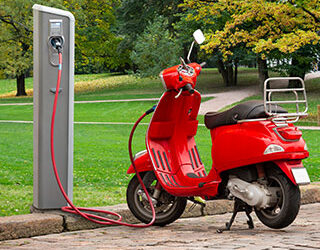Electrifying India: Navigating the State EV Policies for a Sustainable Future

India’s electric vehicle (EV) landscape is experiencing a remarkable transformation driven by multiple factors, with increasing environmental concerns and the need to reduce carbon emissions, EVs have gained substantial momentum. According to data, the India electric vehicle market size was valued at USD 220.1 million in 2020 and is expected to grow at a compound annual growth rate (CAGR) of 94.4% from 2021 to 2030 [1]. In FY2022, 455,733 EVs were sold, according to statistics. The Ministry of Road Transport and Highways of India stated that as of July 2022, there were 1,334,385 electric vehicles operating in India [2].
India, ranking as the third-largest oil importer globally, is poised to make a substantial shift towards electric vehicles (EVs), diminishing its reliance on oil and causing significant disruptions in the global oil markets. If India manages to achieve its ambitious EV adoption goals, it could establish a model for other emerging economies to follow suit, further diminishing their dependence on fossil fuels. The automotive sector is responsible for a staggering 24% of the world’s direct carbon dioxide emission and claims approximately 1.2 million lives each year [3]. Consequently, the widespread adoption of EVs in India would have a profound positive impact by curbing the adverse global environmental consequences stemming from Internal Combustion Engine (ICE) vehicles. Electric two-wheelers have dominated the Indian EV market, constituting over 46% of total EV sales in July 2023 [4]. The affordability and practicality of electric two-wheelers have made them immensely popular among urban commuters.
Furthermore, given India’s vast population of 1.4 billion and its rapidly expanding economy, the country is set to play a pivotal role in the present-day global EV market. The complete transition to electric vehicles in India represents a substantial stride toward sustainable mobility on a global scale. The Faster Adoption and Manufacturing of Hybrid and Electric Vehicles (FAME) scheme, initiated in 2015 followed by FAME II in 2019, and EV policies for Indian states, continue to incentivize EV buyers and have ambitious targets for significant EV penetration [5].
Even after significant investments in the electric vehicle (EV) sector, India faces a notable challenge in achieving substantial EV penetration in rural areas. While urban centers have seen progress in EV adoption, rural regions continue to lag behind due to infrastructure limitations, lower income levels, and limited awareness. The cost of EVs, along with concerns about charging infrastructure and range anxiety. To bridge this gap, targeted initiatives are required, including incentives for rural adoption, expansion of charging networks in remote areas, and awareness campaigns highlighting the benefits of EVs, ultimately ensuring that the electric mobility revolution reaches every corner of the country. Despite challenges related to charging infrastructure and range anxiety, India is steadily expanding its EV charging network, with over 6,586 public charging stations in operation as of March 21, 2023 [7]. Moreover, international automakers like Tesla have ventured into the Indian market, signifying global interest in India’s burgeoning EV sector.
Challenges for EVs Adoption in India
Electric vehicles (EVs) are acclaimed as a promising solution to India’s pressing environmental concerns and energy security challenges. However, the road to their widespread adoption in the country is fraught with hurdles. The most prominent among these is the high upfront cost of EVs. Despite government incentives and subsidies aimed at bridging the cost gap between electric and internal combustion engine (ICE) vehicles, EVs remain relatively expensive, primarily due to the cost of batteries. This factor can deter price-sensitive consumers, especially in a market where affordability plays a pivotal role in purchasing decisions.
Another formidable challenge is India’s nascent charging infrastructure. While some progress has been made in urban centers, many regions still lack a comprehensive and accessible charging station network. This deficiency contributes to range anxiety among potential EV buyers. Establishing a robust and widespread charging ecosystem, particularly in tier-II and tier-III cities and rural areas, is imperative to alleviate this concern and instill confidence in consumers regarding the practicality of EV ownership.
Moreover, battery technology-related concerns, such as battery life, degradation, and proper disposal, persist. The substantial cost of battery replacement can discourage potential buyers and pose environmental risks if recycling and disposal processes are not adequately addressed. Additionally, the majority of India’s electricity source for charging EVs is fossil-fuel-based, primarily coal. To maximize the environmental benefits of EVs, there must be a transition toward cleaner and renewable energy sources. Furthermore, a lack of awareness among consumers about EVs and their advantages, such as lower operating costs and reduced emissions, acts as an impediment to adoption. Initiatives focusing on education and awareness are essential to dispel myths and misconceptions and promote the broader acceptance of EVs in India.
Need for State EV Policies
Implementing electric vehicle (EV) policies at the state level in India is crucial to address the nation’s diverse transportation needs and challenges. India’s vast and varied landscape encompasses varying levels of urbanization, infrastructure development, and environmental concerns across different states. Tailoring EV policies to each state allows for customized incentives, regulations, and infrastructure development that align with local conditions. These state-specific policies play a pivotal role in accelerating the establishment of charging infrastructure, strategically placing charging stations in urban, semi-urban, and rural areas to alleviate range anxiety and make EVs a practical choice for consumers. State-level incentives and subsidies further enhance EV affordability, offering tax breaks, registration fee waivers, and direct financial support to boost consumer interest and drive EV sales. Encouraging the transition of public transportation to electric fleets and facilitating the adoption of electric buses within states can significantly reduce emissions and improve air quality.
Additionally, state governments can prioritize skill development to create a capable workforce for EV maintenance, servicing, and operating charging stations. In conclusion, state-level EV policies are indispensable for harnessing the potential of electric mobility while addressing the unique needs and challenges of each region in India, ultimately contributing to a more sustainable and cleaner transportation future.
State EV Policies
Hover and click over the states for details
Formation of Inclusive State EV Policy
In the quest for a more sustainable future, the formulation of a comprehensive Electric Vehicle (EV) policy is paramount for any region or state. This policy should encompass a multitude of factors and incentives to ensure its effectiveness and inclusivity. At its core, well-defined EV targets serve as beacons, guiding the integration of EVs into transportation systems within specific timeframes. These targets unite efforts toward a shared sustainable vision and drive collective action.
Purchase incentives are pivotal in accelerating EV adoption across diverse segments, from two-wheelers to buses and commercial vehicles. Tax exemptions further enhance the appeal of EVs, making them financially attractive to consumers. Scrappage policies and incentives encourage the retirement of older, more polluting vehicles in favor of cleaner, more efficient EVs, contributing to reduced environmental impact and improved air quality. Access to financing and interest subvention programs ensures that financial constraints do not impede potential EV buyers, making sustainable transportation accessible.
Priority registrations and free permits for EVs foster their proliferation, while green zones promote eco-friendly urban environments. Reserved parking slots, toll fee waivers, and capital subsidies for charging infrastructure underscore the state’s commitment to facilitating EV adoption and nurturing the growth of charging networks. Incorporating renewable energy sources, promoting battery recycling and reuse, and investing in skill development and research and development initiatives complete a holistic EV policy that is forward-thinking, inclusive, and environmentally conscious. By comprehensively addressing these aspects, states can pave the way for a cleaner, greener future in transportation.
References
[1] Retrieved from https://rmi-india.org/insight/indias-electric-mobility-transformation/
[2] Retrieved from https://morth.nic.in/
[3] “Vehicular Emissions in India.” CEEW. Accessed September 26, 2023. https://www.ceew.in/cef/quick-reads/explains/vehicular-emissions-in-india.
[4] Retrieved from https://www.grandviewresearch.com/industry-analysis/india-electric-vehicle-market-report
[5] Retrieved from https://fame2.heavyindustries.gov.in/content/english/11_1_PolicyDocument.aspx
[6] S. A., & Srinewas. (2023). Retrieved from https://evreporter.com/indias-electric-vehicle-sales-trend-july
[7] “Operational Public EV Charging Stations in India.” Press Information Bureau. Accessed September 26, 2023. https://pib.gov.in/
[8] State EV Policies
This blog is written by Dr. Vikas Nimesh, Md Saddam Hussain, Anmol Jain, and Divyansh Khare





